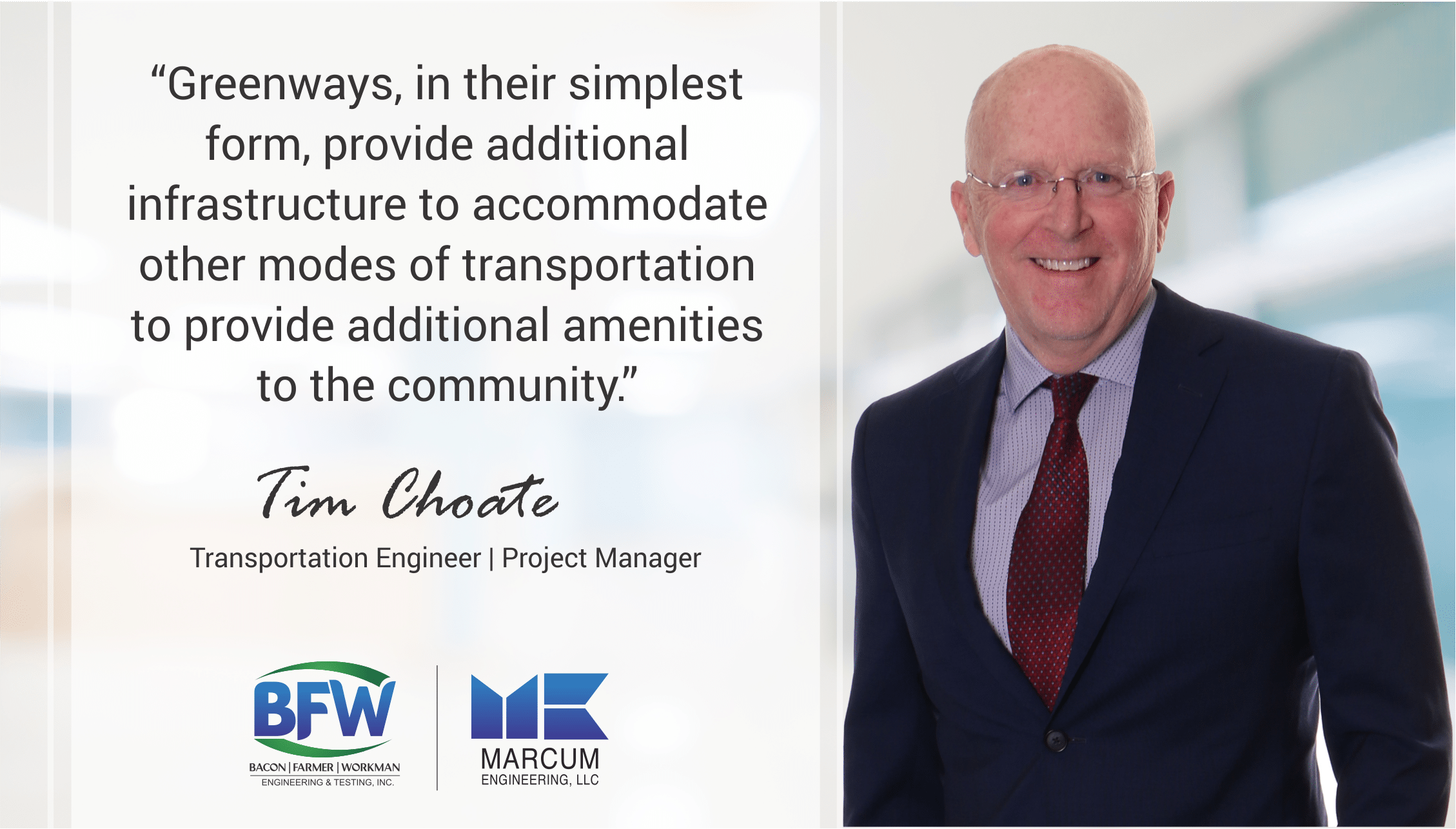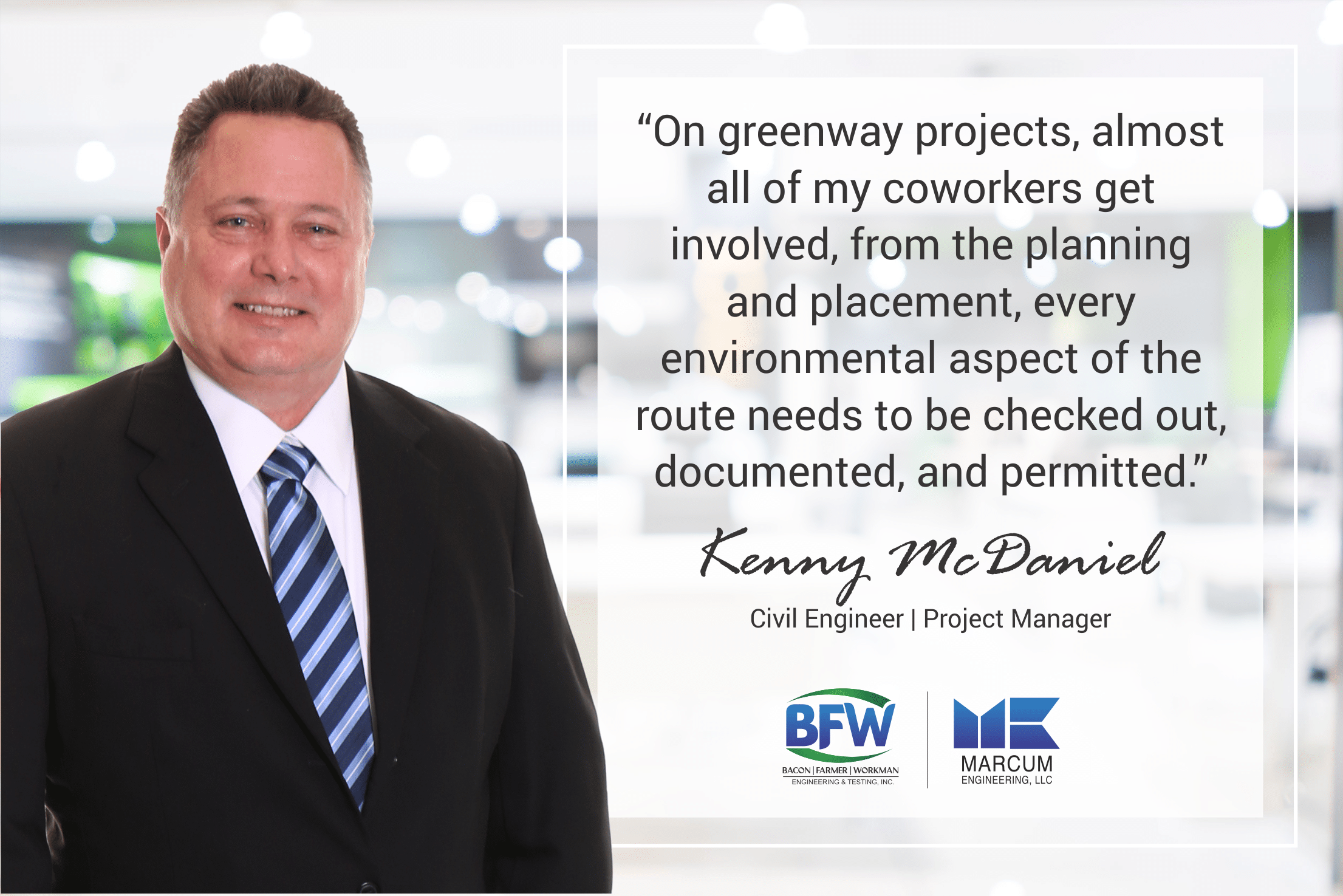What is a greenway? It’s an expanse of terrain designed to be used by cyclists and pedestrians, and when designed well, coexists with the vehicle traffic in the community. What a proper greenway does is give a community a way to exercise and have fun while staying safe. Beyond that, a greenway can connect one community to another, or connect a community to valuable points of interest like retail, grocery, or public service buildings.
What’s not to love? When a community has a greenway, it becomes more connected, healthier, and happier. To us, a greenway is one of the best ways to make a community feel empowered, and it’s one of the primary reasons we love to work on them. We asked some of our team members that work the most on these types of projects what fruits of their labor make them proudest.
Greenways Expand Recreational Options in Urban Areas
Greenways are most impressive when they’re a part of an urban area. Why? Because cities, especially in the Midwest and South, aren’t well-connected as it is. Through the help of greenways, these urban areas can bridge the gaps (sometimes literally) and allow community members wider access to the resources around them.
Maegan Mansfield, Civil Engineer/Project Manager, chimes in. “Greenways are important to communities because they improve the quality of life for users. Our goal is to create an environment that we can all enjoy, and greenways are a vital part of our communities. They are often one of the top things people consider when moving to city.”
Greenways Make it Safer to Travel (for Fun & Work)
Tim Choate, Transportation Engineer/Project Manager, emphasizes the inherent safety when you introduce greenways into a community.

“A multi-use path is a part of the roadway but is typically separated from the vehicle traffic for safety reasons. Multi-use pathways include bicycle paths and accommodations for pedestrians. Greenways, in their simplest form, provide additional infrastructure to accommodate other modes of transportation to provide additional amenities to the community.”
To put it simply, greenways make it safer to travel, no matter the method you use. Walkers, runners, and cyclists get to enjoy the outdoors while keeping a safe distance from vehicles on their daily commute. Most importantly, everyone gets where they’re going safely.
Greenways Can Improve Stormwater Management
Maegan reminds us of perhaps the most underacknowledged facet to a greenway. “Greenways can be used to aid stormwater management, or they can be built on existing infrastructure, such as levees.” As we design and build these spaces, we observe the lay of the land and add valuable storm drainage areas to improve localized flooding.
Communities that are used to flooded streets after a heavy downpour can now stay high and dry, literally! In communities with engineer-led stormwater management systems, all of that water can be safely corralled elsewhere.
Greenways Give Land a New Lease on Life
Kenny McDaniel, Civil Engineer/Project Manager, appreciates that greenways give public land a new lease on life. It opens these spaces to the public while keeping them balanced.
“Greenway trails can be on land that is or has been used for many purposes; they could be pristine woodlands or grasslands, wetlands, former industrial or commercial lands, street/roadway right of ways, abandoned railroad right of ways, flood protection levees, riverfronts, scenic overlooks to name a few.”
Whether you’re rehabilitating a piece of industrial land, or connecting community members to a beautiful, natural area that is right in their backyard but ordinarily just out of reach, greenways connect us to our land.
Greenways Challenge Our Engineers
Kenny goes on to emphasize the importance of collaboration on these projects. A greenway requires many disciplines of engineering working together as one.
“On greenway projects, almost all of my coworkers get involved, from the planning and placement, every environmental aspect of the route needs to be checked out, documented, and permitted.

From there, you need to survey for right of way acquisition and topography. At this stage, geotechnical engineers are used for obtaining soil information for both design and construction.
Simultaneously, civil and transportation engineers typically will lay out the alignment, pavement design, and signage of the trail. Structural engineers get involved when bridges are needed to cross stream, creeks, or provide overpasses/underpasses for streets and roadways.
Landscape architects are utilized for amenities, plantings, and other such items for both the purposes of beautification and completing the project area with the theme of the trail whether that be to tell a story or make it look as if the trail was naturally there. Many trails engage electrical engineers for lighting to extend the hours of usage and the safety of the public. Through construction, testing and inspection engineers are used to guarantee plans and specifications are adhered to.”
It takes a village!
Our Work on Greenways is an Investment in Our Community
We love our work most when we know that every ounce of it directly benefits our community. Greenways are a perfect example of that equilibrium between what you put into a project, and what you get out of it. The more we pour into a project like this, the more we all benefit.
We want the time we invest as engineers to benefit as many people as possible. We’ve long understood that turning a profit is easy; it’s what you decide to put your time into that’s hard. With greenway projects, the choice was easy.
Check out our latest video on Greenways.

Recent Comments